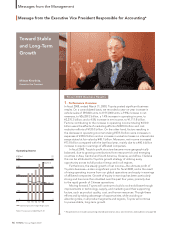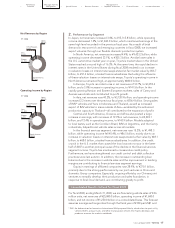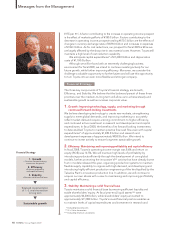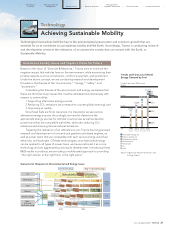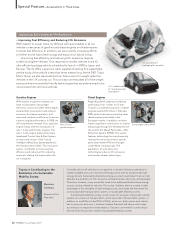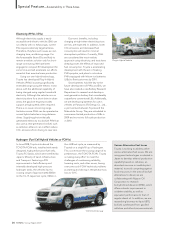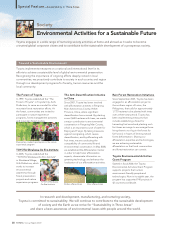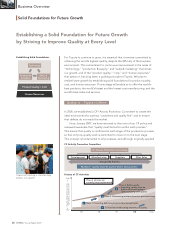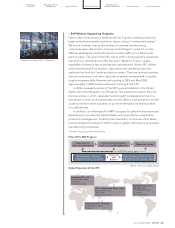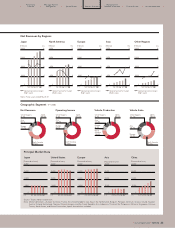Toyota 2008 Annual Report Download - page 27
Download and view the complete annual report
Please find page 27 of the 2008 Toyota annual report below. You can navigate through the pages in the report by either clicking on the pages listed below, or by using the keyword search tool below to find specific information within the annual report.
25
•Annual Report 2008 • TOYOTA
Performance Messages from the Management &
•Overview •Management •Special Feature •Business Overview •Corporate Information •Financial Section •Investor Information •
Driving Simulator
Toyota developed and installed
the new “Driving Simulator” at the
Higashifuji Technical Center in
November 2007, with the goal of
reducing traffic accidents and
promoting the development of active
safety systems. The simulator analyzes
driver characteristics during vehicle
operation and develops and confirms
the efficacy of accident-reduction
technologies. The simulator also offers
a driving experience that is as real as
possible. It is expected to lead to the
development of advanced safety
technologies and vehicle designs
while boosting the speed of
development and lowering
development costs.
Toyota is committed to technological developments based on the Integrated
Safety Management Concept. We are working not only to improve preventive
safety and collision safety but also to offer optimum driver support for every
aspect of driving. These efforts include sensors that detect vehicle
movements, traffic conditions, and even the state of the driver. Computers
are then used to determine the necessary driver support and activate safety
systems. For example, the Pre-Crash Safety System uses a millimeter-wave
radar to detect obstacles such as vehicles ahead and alerts the driver by
sounding a warning buzzer if the system determines that there is a high risk
of collision. If the system determines that a collision is unavoidable, it
automatically activates Pre-Crash Brake to reduce the vehicle’s speed and
Pre-Crash Seatbelt to minimize injuries.
The fully remodeled Crown launched in 2008 integrates the Pre-Crash
Safety System with an eye monitor that detects whether a driver’s eyes are
properly open. A camera
installed on steering
measures facial angle and
how wide open the
driver’s eyes are, and if
it judges that a collision
may occur, it alerts the driver at an early stage, via a warning buzzer and
illuminated display. If the probability of a collision increases and the driver’s
conditions do not improve, the system applies a warning brake to physically
alert the driver.
Through the developments of these and other safety technologies,
Toyota is working to create an even safer automotive society.
Toyota views people, vehicles, and the traffic environment, and aims to attain
the ultimate goal of zero fatalities or injuries in traffic accidents. With respect
to the traffic environment, we are pursuing research and testing of a Safety
Driving Assistance System. We conducted public road tests of this system in
Toyota City, Aichi Prefecture, for the six-month period beginning December
2006. Using 100 vehicles equipped with drive recorders, we collected and
analyzed data on drivers’ behavior under various driving situations on public
roads. The results are being applied to research aimed at reducing traffic
accidents through the development of infrastructure cooperative systems that
support safe driving by communicating information on road conditions, traffic
signals, and other factors with vehicles.
In addition, we are actively participating in the development of the Probe
Traffic Information System, which can provide drivers with information ranging
from estimated travel time to routes to avoid traffic congestion. This helps
smooth traffic flow and consequently reduces CO2emissions.
Traffic Environment Research
Approaches to Safety
10km/h 30km/h 60km/h
10km/h 30km/h 60km/h
0
100
100
0
50
50
CO2 Emissions Volume Comparison
NOx Emissions Volume Comparison
(100 represents 10km/h)
(100 represents 10km/h)
Comparison of Gas Emissions Volume
Depending on Average Speed
Source: Japan Automobile Research Institute
Monitoring area
Calculate opening
and closing of eyelid
Driver monitor camera



